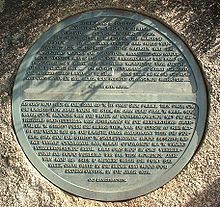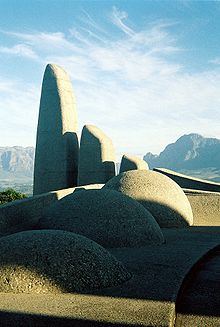Afrikaans Language Monument
The Afrikaans Language Monument (afrikaans Afrikaanse Taalmonument) is a monument in South Africa dedicated to the Afrikaans language. It is located on a hill above the Teachers' Training College in the town of Paarl, which is in the Western Cape province near Cape Town. Built in 1975, it commemorates the century of Afrikaans, which was officially declared its own language in 1925, replacing Dutch as the state language in the then Union of South Africa. The monument consists of various tapering convex and concave structures and symbolises influences of different languages and cultures on Afrikaans itself, as well as on political developments in South Africa:
- bright west - the european heritage of language
- magical Africa - the influence of the African continent on language
- the bridge - between Europe and Africa
- Afrikaans - the language itself
- Republic - declared 1961
- Malay language and culture
On a large plaque at the entrance you can read two inscriptions by famous Afrikaans poets:
- Afrikaans is the language that connects Western Europe and Africa ... This is a bridge between the great heroic West and the magical Africa ... And what there can be a great deal of school understanding - this is what Afrikaans is about. But what we must never forget is that here the change of land and countryside as it was to the new worldly times has been slyp, geknee, gebrei het ... En so het Afrikaans in staat geword om hierdie nuwe land uit te sê ... Ons taak lê in die gebruik wat ons maak en sal maak van hierdie glansende werktuig ... (N. P. van Wyk Louw)
"Afrikaans is the language that connects Western Europe and Africa ... It forms a bridge between the great shining West and the magical Africa ... And what great things may emerge from this connection - that is possibly what lies ahead for us Afrikaans to discover. But what we must never forget is that this change of land and landscape has sharpened, kneaded and knitted this new emerging language ... And so Afrikaans became capable of speaking of this new land from within ... Our task lies in the use we will make of this shining gift ..."
- As ons nou hier in die saal af 'n ry pale sou plant, tien pale, om die laaste tien jaar voor stetel, en aan elke paal 'n merk sou maak op 'n hoogte van die vloer af ooreenkomende met die betreklike skryfgebruik van Afrikaans in die respektiewe jaartal, and a step deur the strange trek from the first one here naby the vloer to the last one therear anderkant teen die solder, dan sou die streep 'n snelstygende boog beskryf, nie net vinnig opgaande nie, maar opgaande na 'n vinnig vermeerderende rede. Let ons nou in ons verbeelding die boog verleng vir die tien komende jare van nou af. Sien u menere waar die punt sal wees, daar buite in die bloue lug hoog oor Bloemfontein, in die jaar 1924. (C. J. Langenhoven)
"If we now erect a row of the pillars along this hall, ten pillars to represent the last ten years, and place on each of these pillars a mark corresponding to the relative written use of Afrikaans in the year in question, and if we draw a line from the first mark here near the floor to the last one there just below the ceiling, this line would describe a rapidly rising arc, and not only rapidly rising, but rising at a more and more rapid rate. Let us now, in our imagination, extend this arc for the ten years now to come. See, dear guests, where the point will be, out there in the blue sky high above Bloemfontein, in the year 1924."
The phrase "DIT IS ONS ERNS" (roughly: "We are serious") is engraved on the path leading to the monument.

"Dit is ons Erns"

Obelisks of the monument in Paarl

Plaque at the entrance

Elements of the monument
Other monuments
The first Afrikaanse Taalmonument was dedicated in Burgersdorp as early as 1893 to promote the desired recognition of Afrikaans. During the Second Boer War it disappeared in an unexplained manner and was only found damaged in King William's Town in 1939. As early as 1907, however, the British government of South Africa had a replica of the original erected.
Today the original is back in its original place; the replica is in the foyer of the municipal library.
Questions and Answers
Q: What is the Afrikaans Language Monument?
A: The Afrikaans Language Monument is the only monument in the world dedicated to a language, built to celebrate the 100 years birthday of Afrikaans being declared as a different language from Dutch.
Q: Where is the Afrikaans Language Monument located?
A: The Afrikaans Language Monument is located in Paarl, Western Cape Province, South Africa.
Q: When was the Afrikaans Language Monument completed?
A: The Afrikaans Language Monument was completed in 1975.
Q: What is the significance of the tapering structures of the monument?
A: The tapering structures of the monument show the influences of different languages and cultures on Afrikaans itself.
Q: What is the political significance of the Afrikaans Language Monument?
A: The monument is a symbol of political developments in South Africa.
Q: What other role does the Afrikaans Language Monument play?
A: As the only monument in the world dedicated to a language, the Afrikaans Language Monument also serves as a unique cultural and historical landmark.
Q: What can be seen from the hill overlooking the Teachers' Training College in Paarl?
A: From the hill overlooking the Teachers' Training College in Paarl, one can see the Afrikaans Language Monument.
Search within the encyclopedia